The ‘gods’ of Japanese cuisine: ‘We have to stop wishing for so many things, and we have to do it now’
Hiroyoshi and Tomiko Ishida, 80 and 81 years old, are a legendary couple in the world food scene. They run Mibu in Tokyo, a haven of technical skills and respect for nature for chefs from all over the planet, a place somewhere between a restaurant, a club and a Zen sanctuary
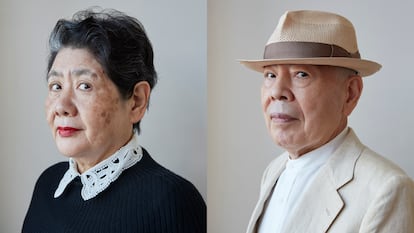

Gonad and semen of puffer fish, turnip in a dashi broth, ayu with its roe (a fried fish that is eaten with the hands starting with the head), sayori (a spring fish) wrapped in dried lotus leaf, rice with sea cucumber, ice water that, upon breaking its frozen layer, liquefies and becomes a pool of silver pearls... and even the Moon on a plate are some of the creations that the couple formed by Hiroyoshi and Tomiko Ishida serve on purified cedar placemats and dinnerware that is over 300 years old at their Mibu restaurant in Tokyo’s Ginza neighborhood.
But is it really a restaurant? Rather, one could describe it as a gastronomic-spiritual Zen sanctuary. Also as a private club where the same or even greater importance is awarded to the food’s textures, shapes, colors and above all symbolism as to the flavors themselves; this is at the original basis of kaiseki, which according to Japanese tradition is a light meal that the host offered to guests before the tea ceremony. Inside a nondescript apartment building, a tiny dining room of barely 20 square meters with a capacity for just eight diners for lunch and eight more for dinner is regarded by the best chefs in the world as an absolute benchmark and the perfect model of tradition turned into avant-garde. Ferran Adrià, of elBulli fame, has said that “in Mibu you cook with your soul and you eat with your mind.” Joan Roca, the Catalan chef who founded the award-winning El Celler de Can Roca, calls it “a pure paradox: being a place of tradition and spiritual cuisine, it represents absolute modernity.”
Tomiko and Hiroyoshi Ishida are respectively 80 and 81 years old. They have been cooking for more than 40 years and serving clients who perhaps should be called followers instead. In the last 20 years they have changed their menu every month. In two decades they have not repeated a single recipe on the menu, nor have they repeated any ingredient in two dishes on the same menu. She is the only person authorized to serve the dishes created by her husband and his three helpers in Mibu’s tiny kitchen. Sometimes they release fireflies that light up the dining room or butterflies that flutter among the visitors. Every day, at the end of the day, the Ishidas go to a Buddhist temple to pray and meditate. They plan to continue working, if the gods and the priestesses they venerate allow it, until they are 100 years old.
Their daily routine has been portrayed by the Barcelona filmmaker Roger Zanuy in the documentary Mibu. The Moon on a Dish, which premiered at the last San Sebastián Film Festival in September. The couple stayed in the northern Spanish resort city for almost a week, accompanied by 20 of their “faithful” (members, helpers and cooking disciples); they received a tribute at the Basque Culinary Center during a dinner served by Barcelona chef Albert Raurich, and toured restaurants and Basque gastronomic societies (traditional cooking clubs) as if they were two foodies in their thirties. EL PAÍS talked with them during a break from their exhausting tour of San Sebastián. Like characters from a bygone era, they were elegantly dressed, smiled all the time, and bowed profusely.

Would you say that your work as chefs is an extension of the spiritual dimension of your life?
Tomiko Ishida. Yes, and also a demonstration of respect for nature. Cooks have to respect nature and take into account the succession of the seasons and the changes and influence on the products; that is essential. The human being cannot create anything without the natural element. By himself he cannot create anything. And this was already predicted 300 years ago: if we continue behaving like this, with similar levels of consumption, we will end up lacking food. In addition, farmers, fishermen and meat breeders are getting older and there is no one who wants to take over.
And what should be done?
T. I. We simply have to stop wishing for so many things. And we have to do it now.
Can you elaborate on that please?
T. I. Yes; if we don’t, it will be too late. That is the message that we want to convey from Mibu to the world. Having desires is fine; having too many is not. Thinking is fine; thinking too much is not. Thinking too much is wanting too many things. And that destroys you. You have to live simply.
Is that the message, that we’re basically doing the wrong thing by disrespecting nature?
T. I. Yes. We have to receive the energy of the Moon and nature within us, and give thanks for that. If not, we will not be able to continue with our task.
There are chefs and food entrepreneurs who sometimes make use of that “sustainable” message and that defense of nature in a somewhat hypocritical way. But in the case of Mibu, it is also on the plate, right? It’s not just theory...
T. I. Exactly. But, like I said, 300 years ago the priestesses were already talking about this, about respecting Mother Earth, the stones, the trees and the plants, and the water..., and if we don’t do it now, there will be a lack of food and water and the destruction of nature.
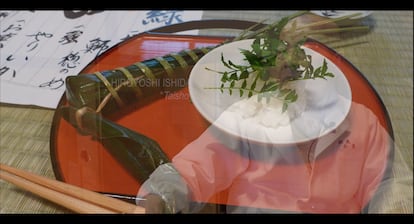
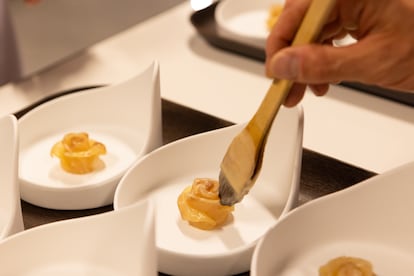
In a country with the cultural weight of Japan – theater, cinema, art, literature – do you consider haute cuisine an art or just a more or less sophisticated way of preparing food?
Hiroyoshi Ishida. No, I don't consider my dishes to be works of art or spectacles at all. I only work with respect for nature in mind, and if a dish comes out like this, it means that my thoughts have materialized that way. And if that dish manages to transmit sensations, thoughts or ideas to the customer, then it makes me very happy. There are many dishes and many cooks who look for rarity or provocation without really giving value to the ingredients. For me that is not cooking.
What would you say cooking is?
H. I. Treat the product as little as possible. The important thing in Japanese cuisine is the essence. Highlight the ingredient instead of killing it.
How do you do that and also come up with the wonderful dishes that end up on your plates?
H. I. By practicing Zen meditation and receiving the keys and advice from heaven. I have been working this way for many years.
But one would say that there is a kind of tension between the apparent simplicity of the creations and their enormous conceptual complexity, which is intuited. Is that so?
H. I. Yes, that's right.
Is simplicity the hardest thing to achieve?
H. I. Achieving what is simple is the most complicated thing for human beings, also when they are cooking. Adding is easy, removing is much more difficult. In the kitchen it is key to find the balance between adding and subtracting... and it is the most difficult thing of all.
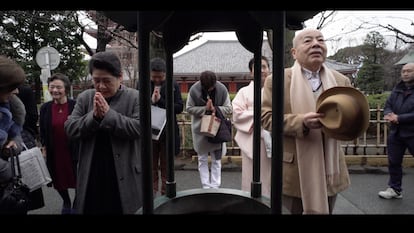
But working against this spiritual intention and aspiration to simplicity, there is an unstoppable avalanche of stimuli from life. How do you cope?
H. I. You are right. That happens to us every day. Everyday thoughts and noise make meditation difficult. And the more you sit to meditate, the more noises you hear!
Is the way you cook in some way a reaction to that everyday noise?
T. I. We think so. Every month we make a new menu, and that means a new creation. For 40 years, we have never repeated one of those monthly menus. It is not easy.
You travel with a whole retinue of clients, members, disciples, apprentices... is Mibu, excuse me for saying so, some kind of good cult?
[Laughter] T. I. In addition to our clients and our workers, there are people who like us a lot and with whom we share many sensibilities. We told a group of those people: “Let’s go to San Sebastián, to the Film Festival.” They told us: “Okay, let’s go!” We told them: “Air tickets and hotels are very expensive.” They replied: “Okay, no problem.” They were willing to come out with us. I admit that ours is a very peculiar world.
How exactly does the Mibu access system work?
T. I. In October of each year we provide our clients with their agenda for the following year. Earlier we had about 300 members and now we have about 220. We usually have two days off a week, we normally rest on Wednesdays and on weekends.
A few days after the interview, Mr. and Mrs. Ishida sent a video to explain and visually show their peculiar table allocation system. In the video, Mrs. Ishida is seen in the dining room of the restaurant, holding up a large white card with Japanese characters written in orange and black: “This is Mibu’s envelope. On the back is written ‘2023′ and there is the member’s agenda for the coming year. We just handed out the last 2023 envelopes to our customers at dinner today. Clients come to Mibu according to this schedule. Several of them have been coming to our restaurant for close to 40 years, that is, once a month without fail, even in Covid times. Mibu receives eight diners maximum per session. Until recently we served three meals a day: at 11am, at 2.30pm and at 6.30pm. When we were younger we could do it, but now we no longer feel capable and we only do the 2.30pm and 6.30pm meals. This is the envelope for next year. So next year is already organized!”
Would you rather talk about members or clients?
T. I. We call them members.
Can only members eat at Mibu or do you accept other clients?
T. I. Only members can eat at Mibu. We do not accept strangers. A member can bring someone if there is room, but is responsible for the guest. And if we don’t want this person to come back, they do not come back.
How much do they pay for a meal?
T. I. They pay 30,000 yuan [about $205] with everything included: taxes, service and drinks, only sake. We serve the same menu at lunchtime and in the evening, we change the menu every month and we never repeat an ingredient within the same menu. Customers bring an envelope with the amount in cash every time they come for lunch or dinner.
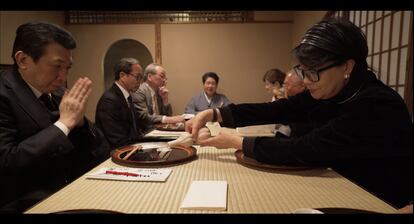
Someone who has been to Mibu can say to a friend: “You eat ice water there, and you even eat the Moon.” But how can you explain it?
[Laughter] H. I. The theme of our October tasting menu was the Moon, yes. That is the time when you can best see the full Moon in Japan and parties and meetings are held around that. And for those festivities we have some traditional dishes. The Moon is a source of inspiration for us. One day I was looking at a crescent Moon and it occurred to me: “I’m going to offer the Moon to my clients.”
What has been the most extreme or radical dish that you have ever served in Mibu?
T. I. When I was recovering from cancer, we went to take a break in the country in winter, and there we saw icicles. Hiroyoshi tasted them and said, “My, the taste of icicles varies a lot from tree to tree.” This is how The icicle plate was born, and we served it at elBulli [during the historic 2003 meeting in Cala Montjoi in which Adrià and Ishida cooked together]. Then, in early winter, a thin layer of ice often forms in puddles or gardens, called usu-goori in Japanese. This ice is so fine that if you tap it, it breaks clean. From there we made The ice plate. They are dishes that were born from the inspiration that Ishida had when we went to the mountains. I think they have been reproduced by various chefs around the world. Ferran and his colleagues were surprised that dishes could be served with just water.
Do you think there could be “common paths” between kaiseki cooking and some forms of Western cooking?
H. I. If there is, I think it could be a sense of seasonality. Also, each country has its own “mother’s kitchen.” If those fundamentals are lost, the kitchen becomes something strange, almost comical. In the kitchen, something very important are the principles. You have to value the mother’s cooking, seasonal products and local products. If not, you will go in a strange direction, and that will be the end of it.
Do you fear that the Ishida legacy will one day be lost?
H. I. We don’t have that fear. In the first place, the kitchen and the palate belong exclusively to each one and cannot be bequeathed to other people or other generations. In the end, a chef, after training and learning enough, must resort to his own sensitivity. The kitchen changes with the sensitivity of each person. Younger people will come out and they will be much better than us. Mibu will end when we stop working. We recently made the 100-Year Declaration; this means that we will continue to be active until we are 100 years old and that we will work in a way that is adapted to our age. To do this, we remember the last thing our priestess Anju-sama told us: “Keep your umbrella at 70%, do not overextend what you do in life against the rain and wind. Don’t be greedy.” It means that a person with 1,000 abilities should use 700 and a person with 10 should use seven.
Will there be a handover when you leave?
H. I. We don’t have any successors, but some of those who trained here have opened their own restaurants. One of them is Daimu and the other is Jisei, both located very close to Mibu. They are based on what they learned from Ishida. Now, this type of membership system is a very difficult thing to do. Many of Mibu’s customers now also go to these ex-Mibu restaurants. In any case, I believe that they should not count on these clients forever, but rather they have to get their own clientele.
What do you admire or look at with curiosity in Western cuisine?
H. I. When I saw Western cuisine for the first time, I felt that the eating experience can be a real fantasy world. When I went to elBulli for the first time I thought: “What a wonderful world.” They served air the same as when we serve water in Mibu. These items do not fill the stomach and people might think: “But what is this dish?” Serving air is an amazing thing. There aren’t many people who can bring those things to perfection. You can make delicious food, but there are few people who can make such fantastic things. It’s a subtle difference, but it’s a big difference. So, Ferran Adrià is a national treasure, I think. Ishida will work until he is 100 years old, so I hope Ferran will also think about how he can fix his big tree so that every year visitors from Japan come to see it. I hope you enjoy doing it and that we do it together.
Tu suscripción se está usando en otro dispositivo
¿Quieres añadir otro usuario a tu suscripción?
Si continúas leyendo en este dispositivo, no se podrá leer en el otro.
FlechaTu suscripción se está usando en otro dispositivo y solo puedes acceder a EL PAÍS desde un dispositivo a la vez.
Si quieres compartir tu cuenta, cambia tu suscripción a la modalidad Premium, así podrás añadir otro usuario. Cada uno accederá con su propia cuenta de email, lo que os permitirá personalizar vuestra experiencia en EL PAÍS.
¿Tienes una suscripción de empresa? Accede aquí para contratar más cuentas.
En el caso de no saber quién está usando tu cuenta, te recomendamos cambiar tu contraseña aquí.
Si decides continuar compartiendo tu cuenta, este mensaje se mostrará en tu dispositivo y en el de la otra persona que está usando tu cuenta de forma indefinida, afectando a tu experiencia de lectura. Puedes consultar aquí los términos y condiciones de la suscripción digital.
More information
Archived In
Últimas noticias
Welcome to the post-religion era: The idea of Christianity as the absolute truth has become obsolete
‘I thought you would like it’: The risky sexual practice popularized by TV shows and TikTok
The digitalization of tourism: ‘They promise experiences and gave us the worst possible one’
Mexican peso defies uncertainty with forecasts of a new period of stability in 2026
Most viewed
- Sinaloa Cartel war is taking its toll on Los Chapitos
- Reinhard Genzel, Nobel laureate in physics: ‘One-minute videos will never give you the truth’
- Oona Chaplin: ‘I told James Cameron that I was living in a treehouse and starting a permaculture project with a friend’
- Why the price of coffee has skyrocketed: from Brazilian plantations to specialty coffee houses
- Silver prices are going crazy: This is what’s fueling the rally










































